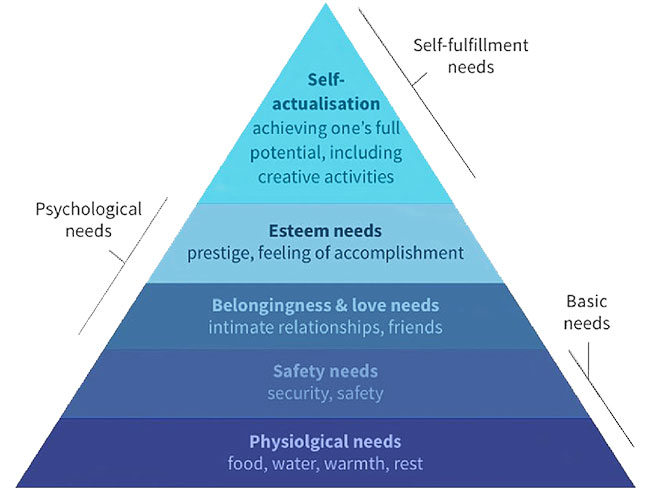Updated June 9, 2023
What is the Role of Emotions in the Algorithm for Consumer Spending?

Image Credit Wikipedia
As marketers, we make it our business to understand what people need, why they need it, and what underlying motivations drive their behavior. At ASTRALCOM, I make a practice of integrating opportunities for relatable, authentic, emotional connection at every juncture in the marketing workflow. This means understanding a company’s unique value proposition, situating emotional needs in the customer journey, and engaging a brand’s many channels in ways that will best resonate with its target audience.
How a customer feels emotionally is rooted in whether their core needs are fulfilled, and what unmet desires open a door for brands to provide a solution. Abraham Maslow’s hierarchy of needs is a useful framework to explain the complex layers of need that may or may not affect your target customer. At the base of the hierarchy of needs are physiological needs and safety needs. Social belonging and esteem come next – and at the top of the hierarchy, there are loftier needs: self-actualization and transcendence. For marketers, chances are, your target customer has fulfilled their physiological and safety needs, and for most businesses, the sweet spot can be found in social belonging and esteem.
These days, a desire for social belonging is pervasive in culture. Aligning oneself with a sports team, political parties, type of music, social group, or even a personal style reveals a desire to fit in. A desire to be a part of something and to represent a set of values, ideals, or idiosyncrasies is one of the primary drivers of human behavior that marketers can tap into. How might your brand be a salve for isolation, or low feelings, or social detachment?
Similarly, a person’s self-esteem has to do with a deep, human need to feel seen and recognized by others. According to Maslow, the recipe to feel valued by others involves gaining recognition and personal status, bundled with feelings of importance and respect. Esteem sits somewhere between feeling confident and skillful, and how one is perceived by others. Obvious ways that the need for esteem shows up in real life is through brand affiliation, distinction through conspicuous luxury goods, and maintaining desirability to peers and outsiders.
A lack of social belonging or esteem can be psychologically damaging to people – and can trap them from achieving higher levels of development. Feelings of estrangement or inadequacy can inhibit a person from living with a sense of satisfaction. Brands should ask themselves what they can do to appeal to customers’ desires to fit in and feel distinguished. For example, how is your brand a conversation starter among friends, neighbors, and colleagues? How can you help your customers to feel proud? What digital engagement strategies can bring customers together and inspire feelings of connection and emotional investment?
Advertisers are also known to tap into customers’ sense of shame – which is related to self-esteem and shows up in all sorts of areas of life, according to author & professor Brené Brown. One’s physical appearance, body image, sexuality, family life, motherhood or parenting status, professional identity, age, religion, public persona, and traumatic experiences can contribute to their experience of shame. At its core, the psychological problem at hand is whether individuals feel accepted, and if not, how they are otherwise seeking pleasure. Because shame can be a painful issue to confront, people are likely to seek out band-aid fixes that offer quick results. There are infinite obvious inroads here for marketers.
Thinking about how your brand can help customers feel good is one easy way to advertise in alignment with your target’s unmet needs – and doing so in an authentic and relatable way can increase your lifetime value to your customers. A holistic marketing approach should help fulfill customers’ emotional needs and offer memorable, lasting value. Learn more about emotional causality and consumer behavior in my recent whitepaper, The Algorithm for Consumer Spending.
This article is part of The Algorithm for Consumer Spending Series.

